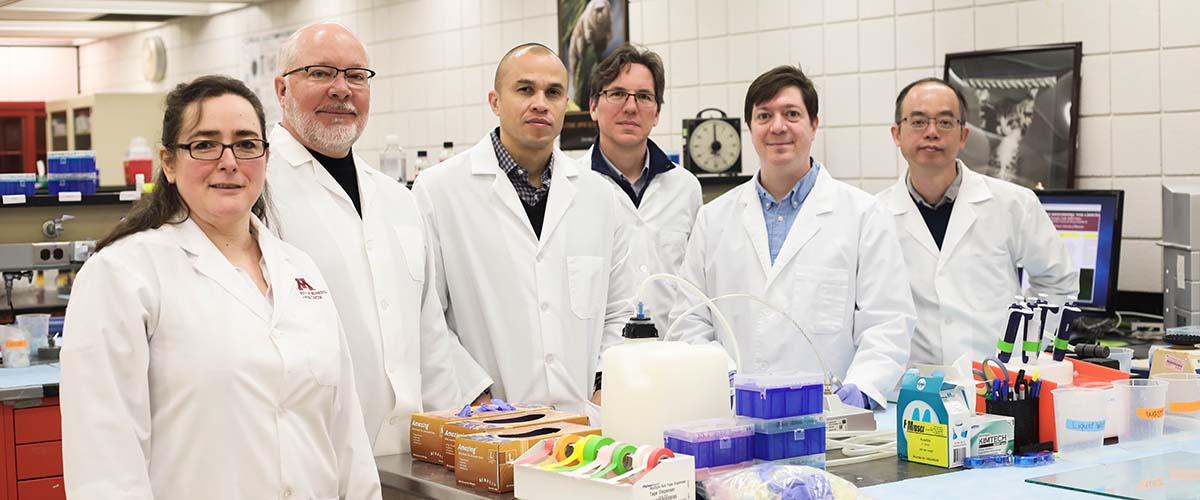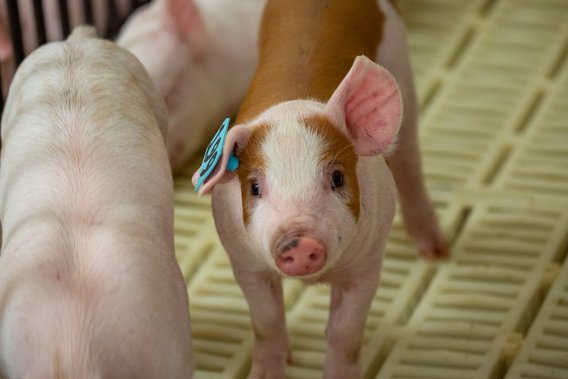
It’s all about the interactions
Using new-to-the-world science and a holistic approach, the U of M’s Integrated Animal Systems Biology team makes discoveries to understand and improve the growth and health of food-producing animals
Pop quiz — what happens when a group of scientists in gastrointestinal physiology, metabolomics, microbiomics, functional genomics, and animal nutrition get together? The answer: You find real-world solutions to complex animal production challenges.
At the heart of these discoveries is the Integrated Animal Systems Biology (IASB) team at the University of Minnesota’s College of Food, Agricultural and Natural Resource Sciences (CFANS). With state-of-the art analytical methods in systems biology, IASB uses molecular biology, bioinformatics and data mining to uncover new information that can improve the ability to more efficiently use calories and nutrients to sustainably feed more people on the planet.
Why is this important? When it comes to figuring out ways to increase animal productivity, we need to first understand the complex dynamics of nutrients, metabolites, microbes, pathways, gene expression, and physiological functions in animals.
In order to meet the protein demands of a growing human population, we must address these challenges with sustainable solutions that promote healthy humans, healthy animals, and a healthy planet. IASB partners with leaders in the animal and feed industries to bring these new approaches and perspectives to the forefront to be a part of creating solutions for producing more abundant, wholesome, and environmentally-friendly protein food products for consumers.
IASB team members from left to right: Milena Saqui-Salces, Gerald Shurson, Andres Gomez, Pedro Urriola, Chris Faulk, Chi Chen.
A truly novel concept
Traditional approaches involving single scientific disciplines are woefully inadequate to solve the complex problems of sustainable food production for a growing population of people. “We’re committed to using ‘omics’ approaches that help us characterize and quantify groups of biological molecules involved in physiological changes and contribute to the dynamic functions of animals under various production conditions,” said Gerald Shurson, professor of swine nutrition in the CFANS Department of Animal Science and IASB team member.
“This powerful collaborative approach enables us to understand mechanisms of nutritional and health responses in animals so we can strategically design optimal feeding programs to enhance animal productivity,” Shurson said.
What the IASB team is doing, Shurson explains, is a totally new concept and novel approach for conducting research in animal science. “We’re using different scientific disciplines and platforms to break apart the different biological responses that occur in the whole animal. Once we have characterized animal responses to nutritional interventions in these subsystems, we then bring the data together to help us connect these complex pieces of information to understand how animals respond to various dietary interventions, which nobody else is doing. This goes far beyond the traditional study of nutrition,” said Shurson.
Shurson’s team integrates biological information from the micro to the macro level. Their research defines cause and effect relationships that provide a view on how nutrients, feed additives, animal hygiene and environmental conditions are involved in improving animal productivity, efficiency and health.
“We’re taking animal science in a revolutionary new direction by looking at the physiological, biochemical, gene expression and immunological pathways and processes involved in the interaction between an animal’s intestinal tract and the components of feed ingredients or additives in a holistic way,” said Shurson.
Breaking it down, adding it up
The IASB team looks at the animal from different directions. For example, they study functional genomics, the biology concerned with the structure, function, evolution and mapping of genomes. They also focus on metabolomics (the study of small molecules, or metabolites, within cells, biofluids, tissues or organisms); and microbiomics (the study of the combined genetic material of the animal’s microorganisms); and gut physiology, which addresses the physical function of the animal’s gastrointestinal tract and its connections with the immune system and metabolism.
With this unique combination of molecular analytics and integration of data mined from a wide variety of sources, the team can form a comprehensive assessment of animal performance and efficiency from using natural functional feed ingredients and nutrients that provide health benefits beyond their nutritional value.
“When we make a nutritional change in one area, we can see a multitude of different responses happening within the animal’s system and note how they are changing in a positive or negative way,” said Shurson. “By doing that, we’re discovering why things are happening the way they are, and that’s really what our industry partners are looking for — to be able to strategically use dietary changes to achieve predictable animal growth and health responses.”
Shurson notes that the IASB team is only scratching the surface of all there is to be discovered. “We look forward to continuing our collaboration with industry leaders and producers,” he said. “As we integrate knowledge to understand the complex mechanisms underlying animal growth and health responses, we will continue to improve overall animal productivity, efficiency and health — and that’s a sustainable solution for everyone.”
Learn how the IASB team is collaborating with organizations including the Norwegian University of Life Sciences and Cargill in the accompanying video.







